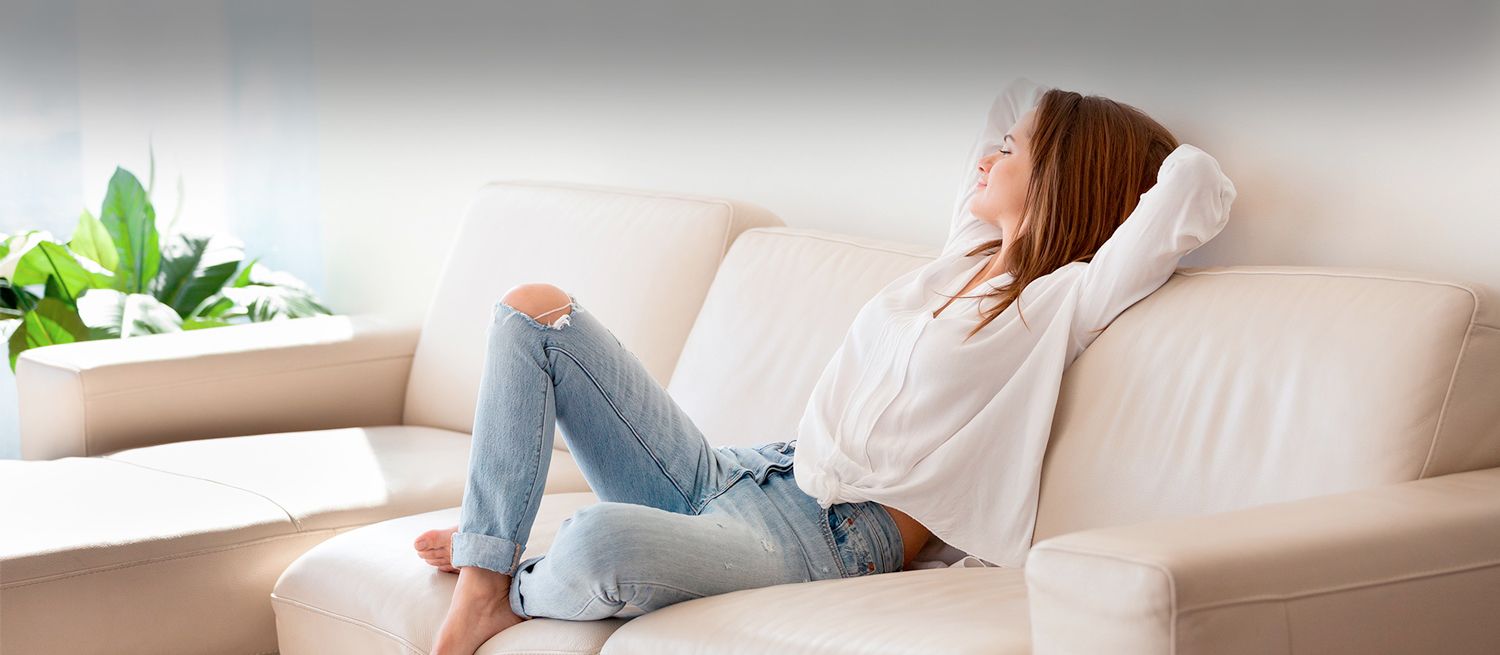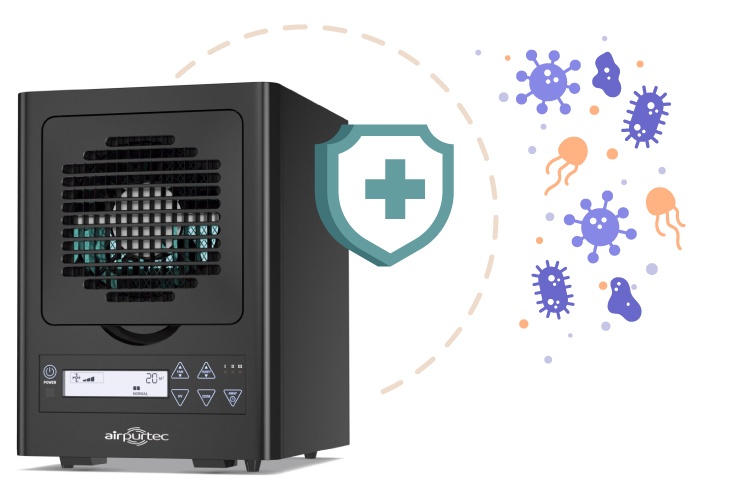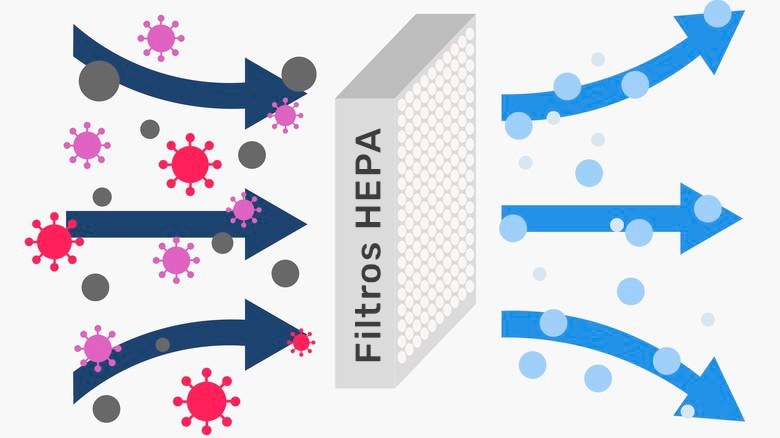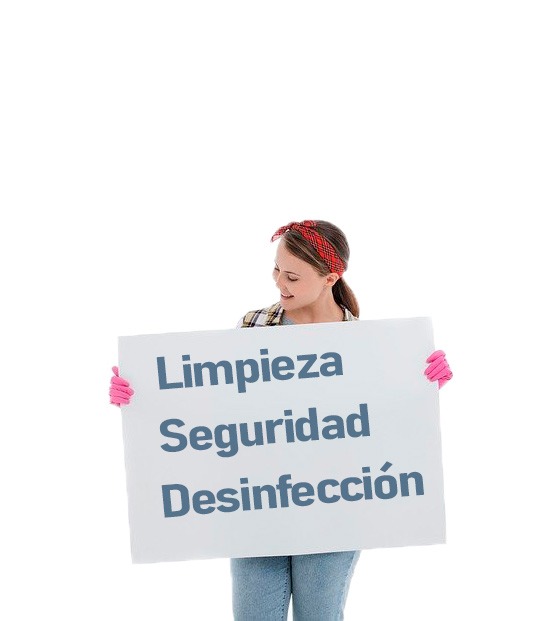
Why buy an air purifier and how to choose it?
Simply because of its ability to improve indoor ambient air quality. The air purifier seems to us such an effective, practical and simple solution that will help you reduce the risk of disease.
While outdoor air pollution has been talked about for decades, indoor air quality has more recently become a public health problem, much more so today with the Covid 19 coronavirus pandemic.
Between home, office, transportation, restaurants ... we spend more than 80% of our time indoors. And indoor air is even more polluted than outdoor air , hence the growing interest in air purifiers.
Buying a purifier is a profitable investment for your well-being and we have high-performance models at reasonable prices, health is priceless.
But what is an air purifier? Who are they for? How do they work? And how do you choose the correct one? Why buy an air purifier?
What is an air purifier?
An air purifier is a device capable of purifying the ambient air in your home or workplace to improve its quality. An indoor air purifier targets all indoor air pollutants, therefore it is a solution to fight against dust mites, tobacco smoke, pollen, toxic emissions, fine particles or any other toxic substance. found in our ambient air.
The most advanced purifiers on the market are also capable of eliminating viruses, coronaviruses and bacteria and incorporate up to 7 different purification technologies.
They also have the filter system, photocatalytic oxidation, ionization and even ozone technologies (independently connectable to be used mainly in unoccupied spaces).
Thanks to various technologies, the air purifier will be able to neutralize toxic pollutants invisible to the human eye, thus reducing the risk of diseases, but also improving your comfort and well-being. The beneficial effects of clean air are manifold.
Who are air purifiers for?
Everyone has an interest in breathing clean air, which is why we all benefit from having an air purifier in the office or at home to take care of our health and well-being. For sensitive people it is even almost indispensable, for example, for victims of respiratory and asthmatic diseases, allergy sufferers, the elderly, children and babies. In this case, an air purifier provides a true haven of peace, immediately reducing the risk of illness or breathing difficulties.
People suffering from allergies, asthma or respiratory diseases are, of course, the main audience for air purifiers. In a polluted indoor environment, these sensitive people may experience respiratory discomfort, sneezing, redness or itching of the eyes ...
Spring is a good time for allergies due to the proliferation of pollen. Therefore, you might think that it is the ideal season to use an air purifier. However, these devices are useful throughout the year. Indoor air is even more polluted than the air we breathe outdoors, and indoor pollution is not just pollen. The particles that pollute the air in our homes not only come from outside, but, on the contrary, they emanate from our homes and are therefore present throughout the year.
Because that is the difficulty of air pollution problems, that the finest and most harmful polluting particles are invisible to the naked eye. Therefore, it is difficult to assess the state of the air we breathe.
However, all interiors are "polluted" regardless of location and season. For this reason, it is recommended to open the windows for 10-15 minutes a day, both in summer and winter.
Finally, if you have pets or smokers at home, it is an equipment that will effectively absorb cigarette smoke, bad smells, pet hair or other allergens. Useful whether you are sensitive or not!
What are air purifiers for?
We hear a lot about air pollution and fine particulate matter, but indoor pollution is of a different nature. Although some particles are visible (such as dust in the air), it is above all the finest that must be eliminated so that they are not inhaled. According to the WHO, all particles smaller than 10 microns (PM10) are dangerous to health, particularly those that measure 2.5 microns or less (PM2.5).
A small part of the indoor pollution comes from outside (pollen, road traffic ...), but most of it is inside. This is mainly caused by our activities, when we cook or use cleaning products, DIY products, when we burn candles or incense ... Mold or humidity in the house also pollutes the air, as well as viruses and dust mites .
Finally, some polluting particles emanate from building materials, furniture and decorative objects, such as VOCs (volatile organic compounds), including formaldehyde. These volatile substances are difficult to capture and the activated carbon filter is not always sufficient to filter out all VOCs.
Therefore, the air purifier allows you to filter the air in the home to remove many of these particles that are harmful to health.
How does an air purifier work?
The air purifier sucks in the air in the room and then discharges it purified, free of many of the polluting particles, which are also irritants and allergens . Depending on the type of purifier, the air passes through various filters. First a pre-filter that retains the coarse particles, often visible to the naked eye such as dust, hair, animal hair ... Then the air passes through a HEPA filter (High Efficiency Particulate Air) that retains the finest particles invisible to the simple view down to 0.3 microns cleaning up to 99%. Finally, the activated carbon filter, which retains gases, odors, smoke and certain volatile organic compounds.
It should be noted that some manufacturers have merged the filters so that their purifiers have only one, easier to maintain. They do not bypass the uptake of fine particles or gases. These filters are simply made up of several layers and therefore combine various functions.
Depending on the type of model you choose, your indoor air purifier will use a variety of processes and technologies to purify your air, from the simplest to the most sophisticated.

Can an air purifier remove viruses?
The HEPA filter removes very small particles that are invisible to the naked eye, but are not equipped to absorb viruses, which are generally finer than 0.3 microns. As a result, the virus will pass through the filter. Bacteria, on the other hand, are more efficiently absorbed by the HEPA filter.
Note that the maximum efficiency in air purifiers is obtained when, in addition to filtering, photocatalytic oxidation and ionization systems are integrated. Photocatalytic oxidation, advanced heterogeneous photocatalysis or radiant catalytic ionization involves the destruction of particles through the production of a purifying plasma that effectively and safely removes up to 99.9% of bacteria, viruses, harmful contaminants and molds on surfaces and in the air . The ionization process removes airborne particles by precipitating them to the ground (the device produces negative ions that make the polluting particles stick together, becoming heavier).
How to choose your air purifier?
To ensure that you find the best air purifier - the one that truly meets your needs - you will need to study its various features. First, find out about the technology used . There are different technologies available, and not all are equally effective. They include HEPA filtration, activated carbon filtration, ionization, photocatalysis, etc.
Then, once the technology has been validated, it will be necessary to study the performance of the air purifier, both in terms of the pollutants against which it is effective and the capacity that the air purifier will be able to treat, in other words, the size of the room in which it will be effective . Plus, find out how easy it is to maintain, its noise level, its power consumption, and the cost of replacement filters.
The most sophisticated purifiers on the market with Hepa filters filter very small particles (down to 0.3 microns) with efficiencies greater than 98 or 99%. But then why such price differences, knowing that the first prices start around 300 euros and go up to more than 2,000 euros. These are the criteria that should not be neglected to make the right decision.
- Check the different technologies that the purifier incorporates and if it is useful for the application that we are going to give it. It is not the same to want to filter the air than to want to have the spaces disinfected and clean of viruses and bacteria.
- The air flow rate, expressed in m3 per h, indicates how much air the purifier can handle. Thanks to these data, you can choose a purifier adapted to the size of the room you want to purify. Manufacturers generally supplement these figures with more meaningful data, such as the area covered by the unit. Tip: It is better to use a model with a high air flow to treat a small room than the other way around. The room is more likely to become "healthy" more quickly.
- The presence of specific high-capacity filters is an advantage for having extremely clean air, but if we are also interested in the elimination of viruses and bacteria, we must consider the purchase of a purifier with heterogeneous photocatalytic oxidation, which is currently the most advanced technology advanced.
- The price of filters should not be neglected to avoid unpleasant surprises. In fact, the pre-filter should only be dusted or washed under running water, depending on the model. On the other hand, the HEPA filter and the carbon filter should be changed regularly to preserve the efficiency of the purifier. The recommended change frequency varies from model to model: from 3 months to about 6 or 8 months - up to 1 year for some. The price of these filters also varies and can go up to 60 euros. Please also check whether these consumables are easily accessible and can be purchased from your dealer.
- Filters are essential to the operation of the purifier, so make sure you can easily obtain these consumables and feel free to take a look at the quality of the filters, if you can (stiffness, thickness, presence of a "frame" ... ).
- Aerosol-type purifiers are discouraged and even prohibited by health if they drive biocides, because the particles of liquid in suspension are harmful and can spread coronaviruses such as Covid 19 in the air. In addition, there are aerosol-type purifiers on the market that spray air freshener-type liquids with limonene at a cost of € 50 per quarter of consumables.
Advantages of purifiers

Mites
Destroy mites.

Virus
Eliminates up to 99.9%, including the coronavirus family.

Bacteria
Reduces the risk of bacterial diseases.

Pollen
Effective against allergies.

Chemicals
It breaks down VOCs.

Mold
Removes mold from surfaces.

smells
Break the bonds of the smoke.

Gases
Reduces the risk of poisoning.

Smoke
Neutralizes and reduces related risks.
Why use an air purifier?
An adult breathes an average of 10 kg of air per day. This is more than you eat (1kg), and more than you drink (2kg). Therefore, our body is mainly made up of the air we breathe.
Air pollution is today a proven public health phenomenon, so much so that our governments are launching awareness campaigns. In addition, according to scientists, it is very possible that due to globalization, pandemics are becoming more frequent worldwide.
If you have sensitive people, babies, pregnant women or the elderly in your home, buying an air purifier will only benefit you, as it will improve the quality of the air you breathe and reduce the risk of illness.
In view of its many benefits, investing in a quality model is often worth it.
The options of a purifier
- For the purifier to be effective, its filters must be changed regularly. Therefore, it is useful to have warning lights to know when to change filters.
- Programming is practical because it allows you to plan the operation of the device. For example, it gives you the ability to run the purifier when we leave the house by activating additional disinfection and odor removal systems such as ozone so that the air is clean when you arrive.
Can air purifiers be quiet?
In general, the noise level of an air purifier does not exceed 60 dB (A) at maximum output. However, it can be very quiet when in the lowest mode. Some air purifiers even have a "night" mode, which is not supposed to disturb the user in their sleep. The night mode is interesting if the unit is likely to work in a room, it reduces the fan speed and therefore the noise level.
To make it as comfortable as possible for you to use, be sure to choose a quiet air purifier. Keep in mind, however, that this will largely depend on the airflow of the air purifier . For example, if your unit has adjustable airflow, the volume of the sound it produces will be different depending on the speed you choose. In either case, for fan air purifiers, aim for a quiet mode that does not exceed 30 db (A).
Air purifier size
The size of the air purifier is also an essential feature when it comes to selecting the air purifier that makes for you. That said, beyond the physical size of the air purifier, which is useful to know if it is simple to transport or on the contrary bulky, it is above all the effective size of the purifier that interests you. In other words, the size of the filters, the turbine, etc ... As a general rule, a "large" air purifier will work better than a small one .

Location and consumption
In general, portable air purifiers are accessories that can be installed anywhere. Ideally, however, they should be located in the areas most prone to contamination, such as smoking areas or poorly ventilated rooms . In addition to the rooms where you spend more time, such as bedrooms.
Then, in a given room, the purifier should be able to circulate the air throughout the room. An air purifier hidden behind a door will be of no use. So before you buy your purifier, think about where you can install it, mainly at a height of 1.5 meters or higher for better air distribution.
Since an air purifier will be able to work permanently, you will have to be very attentive to its energy consumption. However, the less they consume, the less they can ventilate the room and their efficiency will be reduced. Above all, think about your electricity bill. The consumption equivalent to a light bulb seems advisable to us, that is, around 50W.
Ease of maintenance and filter change
To ensure the long-term performance of your air purifier, you will have to maintain it and change its filters and other components depending on the built-in technologies . Make sure filter replacement is easy and can be done without tools.
Also ask for the price of replacement filters and the budget for at least 3 or 4 filter changes. Beware of filters that are too cheap.
A filter that is too cheap, for example, less than 20 euros, is probably a low grade EPA filter, or one with activated carbon that is too light. Lastly, favor brands that offer after-sales support and will stay on the market for a long time so that you can buy your filters long-term.
When in doubt, ask them, and you will see from their reactivity and type of response, if these brands are reliable.
Types of purifying filter and technologies
A single air purifier can combine multiple technologies to effectively remove as many pollutants from indoor air as possible . This chapter lists the different types of filtration systems and technologies available on the market.
There are various types of filters, HEPA, activated carbon, catalytic, electrostatic, pre-filters, etc.
Choosing the correct technology, and then the correct filter type is essential.
Next, we detail the different types of filters and their specificities.
HEPA filter
The HEPA filter is a benchmark because it effectively blocks fine particles at a very reasonable cost. Filter is a medical environment, can block dust mites, pollens, heavy metals, smoke particles, bacteria, etc .
However, pay attention to the quality of the HEPA filter. Although all HEPA filters block more than 99% of the particles they attack, not all target the same particles. Some filters only block the largest particles, and they are called EPA E10, E11 filters. However, a high performance HEPA filter must block out the finest particles, because they are the most damaging. If the HEPA H12 filter is the most widely used, the HEPA H13 filter is in our opinion the most suitable for domestic use. In fact, it will absorb the finest particles, leaving enough airflow to purify a large volume of air quickly. Make sure you know the HEPA filter type for a certain air purifier, and remember that if the filter grade is not given,

Activated carbon filter
In addition to the HEPA filter, the activated carbon filter is also a reference. Its advantage is that it filters effectively what the HEPA filter does not. Therefore, the two go very well together. Activated carbon targets fumes, gases, and bad odors . These are molecules that are much smaller than the finest particles. But here also be careful, there are different types of activated carbon filters, depending on the amount of activated carbon used. Preferably select heavy activated carbon filters, whether filled with activated carbon dust or granules, which will remain effective for much longer.
Advanced heterogeneous photocatalysis or advanced photocatalytic oxidation

The unique cells of PXCELL® advanced heterogeneous photocatalysis technology are designed in a honeycomb shape with a unique composition of various metals and UVX light. They generate a purifying plasma that effectively and safely removes up to 99.9% of bacteria, viruses, harmful contaminants, and molds on surfaces and in the air .
Passive technologies such as Hepa filters, UV light, etc. ... are only effective when the pathogen reaches them, that is, when it is aspirated and absorbed by the machine, which is not effective, for example, to clean infected surfaces such as tables, walls , floors, etc ...
This active technology generates purifying agents using ambient water vapor that destroy pollutants and irritants at the source of the problem, air and surfaces, and provide great benefits to indoor air quality.
Scientific tests, carried out by laboratories and different universities, demonstrate the effectiveness of technology in reducing the bacterial and virological load.
Ionization
The ionizer (or negative ion generator) generates negative ions in the ambient air . Since pollutant particles usually have a positive or neutral charge, they quickly fall to the ground as soon as they come into contact with it or can be easily filtered. Negative ions are also known to provide a stimulating sense of well-being.
